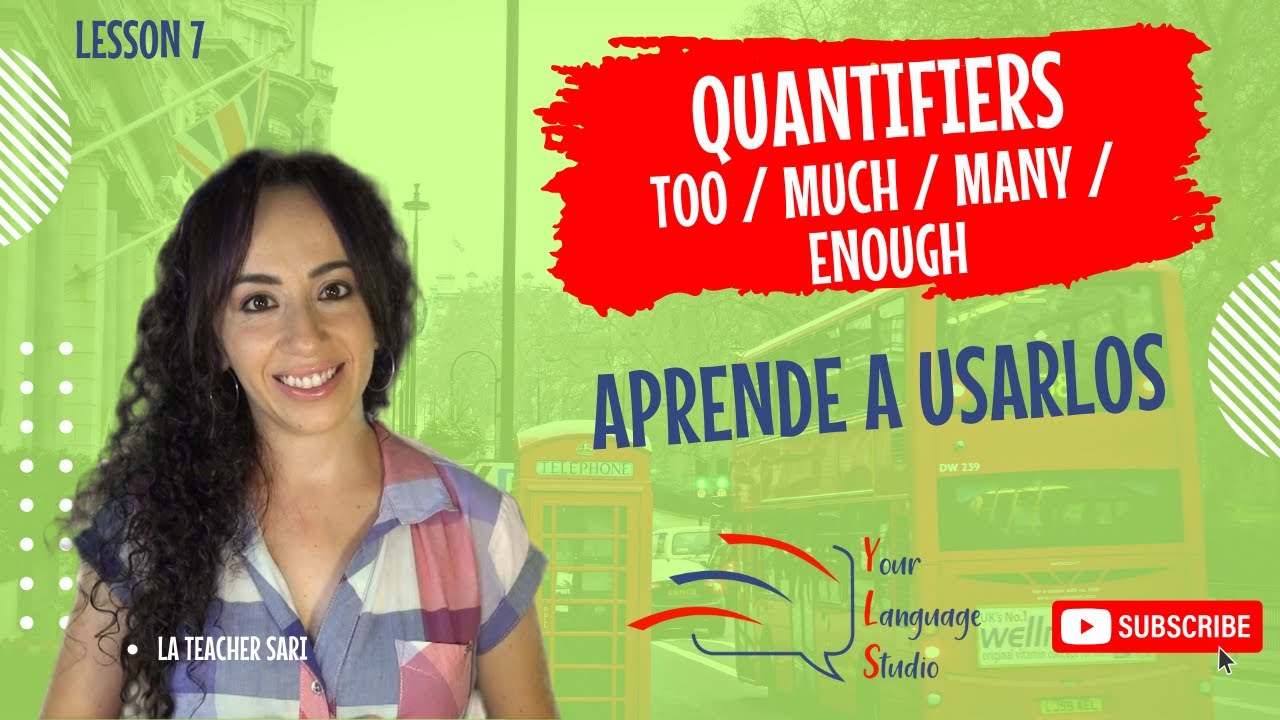QUANTIFIERS in English | SOME or ANY? MUCH or MANY? | How to use? | Grammar | All American English
Summary
TLDRThis video explains quantifiers, which indicate amounts or quantities, and how to use them with countable and uncountable nouns. It covers key quantifiers such as much, many, lots of, a lot of, few, a few, little, a little, some, and any. The video emphasizes when to use these quantifiers in different contexts, such as questions, negative statements, and positive sentences. It also highlights the importance of identifying whether a noun is countable or uncountable to choose the correct quantifier. The video concludes with examples and a preview of a future test on quantifiers.
Takeaways
- 📊 Quantifiers indicate amounts or quantities of things.
- 🍎 Countable nouns, like 'apple', can be pluralized (e.g., apples).
- 🏖️ Uncountable nouns, like 'sand', cannot be pluralized.
- ❓ 'Much' is used with uncountable nouns, typically in questions and negative sentences.
- 🚗 'Many' is used with plural countable nouns, also mainly in questions and negative sentences.
- 🍞 'A lot of' and 'lots of' can be used with both countable and uncountable nouns, usually in positive sentences.
- 👨🎓 'Few' and 'a few' are used with plural countable nouns to indicate a small amount.
- ⌛ 'Little' and 'a little' are used with uncountable nouns to indicate a small quantity.
- 😊 'Some' is used with both countable and uncountable nouns in positive sentences, offers, and requests.
- ❌ 'Any' is used with both countable and uncountable nouns, typically in negative sentences and questions.
Q & A
What are quantifiers and how are they used?
-Quantifiers indicate amounts or quantities of things. They help determine how much or how many of something there is, and can be used with both countable and uncountable nouns.
What is the difference between countable and uncountable nouns?
-Countable nouns can be counted individually and can be made plural, like 'apple' or 'car.' Uncountable nouns, such as 'sand' or 'ice cream,' refer to things that can't be individually counted and are often treated as singular.
How is 'much' used as a quantifier?
-'Much' is used with uncountable nouns, usually in questions and negative sentences. For example, 'How much ice cream do you want?' or 'You don’t have much time before the bus leaves.'
When should you use 'many' as a quantifier?
-'Many' is used with plural countable nouns, mainly in questions and negative sentences, to indicate a large quantity. For example, 'How many cookies do you want?' or 'There aren’t many cars on the highway today.'
Can 'a lot of' and 'lots of' be used with both countable and uncountable nouns?
-Yes, 'a lot of' and 'lots of' can be used with both countable and uncountable nouns, typically in positive sentences. For example, 'There is a lot of bread on the table' (uncountable) and 'There are a lot of windows in that house' (countable).
What is the difference between 'few' and 'a few'?
-'Few' indicates a very small, almost insufficient amount of something, often with a negative tone. 'A few' suggests a small but sufficient amount. For example, 'Few students walk to school' (implying not many do), while 'A few students walk to school' (implying that some students do).
What happens when 'quite' is added before 'a few'?
-When 'quite' is added before 'a few,' it changes the meaning to imply a larger quantity. For example, 'Quite a few students walk to school' means that many students walk to school.
How are 'little' and 'a little' used differently?
-'Little' means a very small amount, often implying near-insufficiency, while 'a little' suggests there is some, even if not much. For example, 'We had little time to prepare' (very little or almost no time), and 'We had a little time to prepare' (some time, but not a lot).
When should 'some' be used, and with what types of nouns?
-'Some' can be used with both countable and uncountable nouns in positive sentences, offers, and requests. For example, 'He has some friends' (countable), 'Would you like some coffee?' (uncountable, offer), and 'Could I borrow some money?' (uncountable, request).
What is the function of 'any' in questions and negative sentences?
-'Any' is used with both countable and uncountable nouns in negative sentences and questions. For example, 'She doesn’t have any friends at this school' (negative) and 'Is there any money in your bank account?' (question).
Outlines

Cette section est réservée aux utilisateurs payants. Améliorez votre compte pour accéder à cette section.
Améliorer maintenantMindmap

Cette section est réservée aux utilisateurs payants. Améliorez votre compte pour accéder à cette section.
Améliorer maintenantKeywords

Cette section est réservée aux utilisateurs payants. Améliorez votre compte pour accéder à cette section.
Améliorer maintenantHighlights

Cette section est réservée aux utilisateurs payants. Améliorez votre compte pour accéder à cette section.
Améliorer maintenantTranscripts

Cette section est réservée aux utilisateurs payants. Améliorez votre compte pour accéder à cette section.
Améliorer maintenantVoir Plus de Vidéos Connexes

Learn English - Countable and Uncountable Nouns

LESSON 7: QUANTIFIERS TOO/TOO MUCH-MANY/ENOUGH

Countable and Uncountable Nouns: Food (Basic ESL)

MUCH vs. MANY vs. A LOT OF | Learn English Grammar with Woodward English | A LOT OF or LOTS OF?

MUCH / MANY / A LOT OF: APRENDA A REGRA! (Countable/Uncountable nouns)

Countable & Uncountable - Brasil Escola
5.0 / 5 (0 votes)
